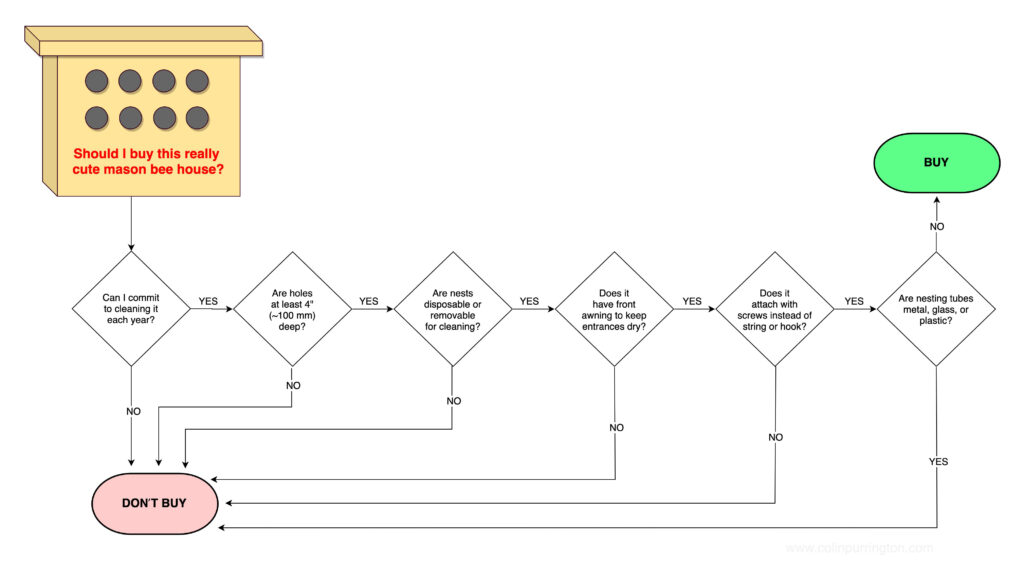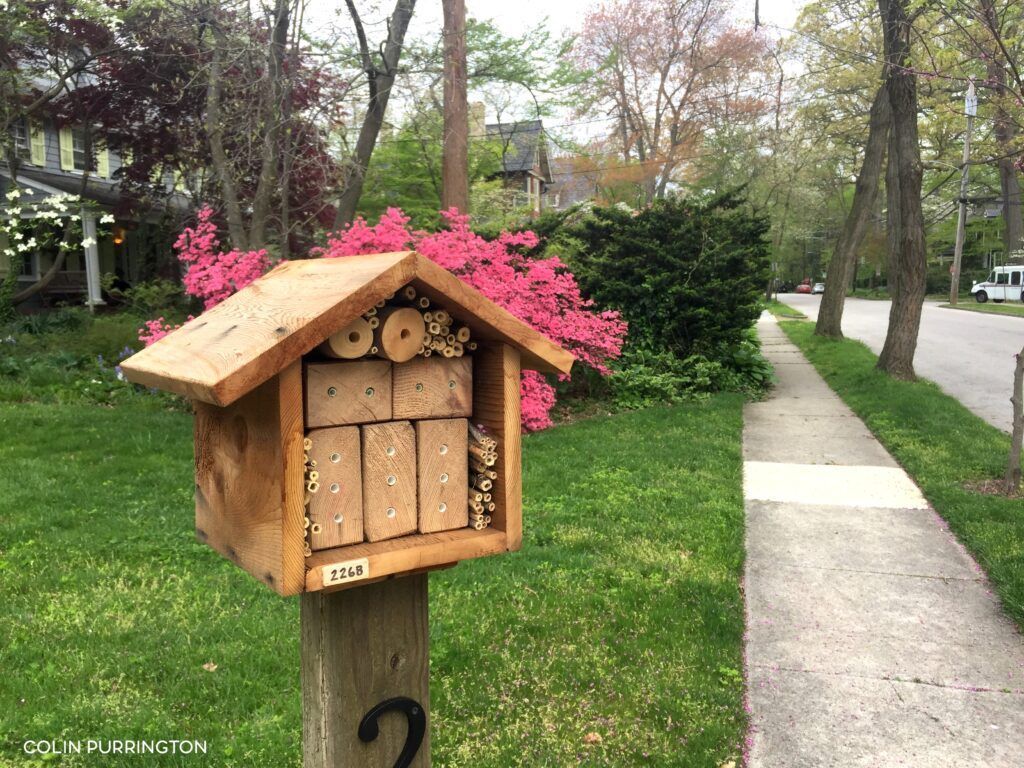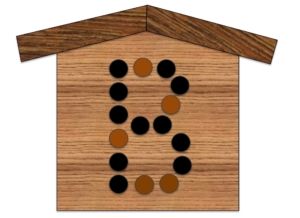Here are some reasons why cheap mason bee houses can end up hurting bee populations. I live in Pennsylvania (USA), so some of the issues might be specific to my location. And to the species that live here, of course. Check with your local authorities for more detailed advice.
1. Nesting blocks, tubes, reeds are not removable
Glued nesting materials is the number one reason why most commercial bee hotesl can become death traps. Because the nesting material cannot be removed and cleaned, over time there will be an increase in the population of parasitic wasps, parasitic bees, parasitic flies, kleptoparasitic mites, fungi, bacteria, and viruses. And you typically won’t see these dangers because the solitary bees will still use the hotel (they can’t help themselves). Here’s a photograph of the mites that tend to build up when bees reuse the same house every year. Sometimes they have so many they can’t fly anymore.

Ideally, empty out the house every year or two and give it a good cleaning. You can do this by removing all the filled nesting tubes at the end of the season (e.g., October) and storing them in an unheated garage or shed. Then, in the early spring put these nests inside a cardboard box that is equipped with a small exit hole — so bees can escape but can’t re-inhabit the nests. Finally, once everyone has emerged, clean the trays (brush, wash with bleach), re-drill holes (for blocks), and throw away reeds and paper tubes. While all this is happening, equip your (cleaned) house with fresh nesting trays, blocks, paper tubes, reeds, etc. All of this can’t happen, of course, if everything is glued in place.
If the above sounds like way too much maintenance, perhaps don’t buy a mason bee house. Get a garden gnome or a gazing ball.
2. Nesting tubes cannot be opened
Even if you clean the house every year and put in fresh tubes, the tubes filled in the prior year might be filled with parasitic flies and wasps. The ONLY way to get rid of them is to pry open the tubes and examine each pupa. And you can only do this if you use paper straws (that you can unwap) or if you use routered nesting blocks (that can be taken apart). So if you want the best accommodations for your solitary bees, opt for either of these designs. Bamboo is really difficult to split open, by the way, which is why I don’t use it for my bee hotels. Big Bamboo is probably going to sue me.
3. Nesting tubes open at back
If holes aren’t capped in some way at the back, parasites can easily gain entrance. Mason bees will plug the back with mud but it’s best to have a wall.
4. Reeds or holes with large splinters
Sharp edges inside the holes can snag and tear delicate wings.
5. Stems blocked at front
In houses that use bamboo, sometimes many of the sections are blocked off near the front by an impenetrable node. E.g., many of the tunnels are too short to be of much use.
6. Tunnels are not the right diameter
If reeds or bamboo are used in the house, make sure that they are all the diameter that supports the species of bee you want to attract. Solitary bees will end up using tunnels that are too wide but they will waste mud (and time and energy) filling them up. Bamboo houses are often a problem in this regard. (If you want to attract all different types of hole-nesting insects, then diversity in diameters is fine.)
7. Roof lacks overhang
Mass-produced mason bee houses are designed to be as compact as possible so they can be packed and shipped efficiently from factories in Asia. This usually means that they won’t have roofs that protect the nest entrances from water. Moisture causes larvae to rot and also seems to cause kleptoparasitic pollen mites to flourish. If your house is fine except for the roof, get creative and attach one. Or stick it someplace that is under a pre-existing structure.
8. House attaches to tree with string or hook
Mason bees start their lives as eggs on top of a mound of pollen, and houses swinging in the wind could cause them to fall off or be crushed by moving pollen balls (when too dry they can shift). At least that’s the word on the street. Perhaps a more important reason to keep the house stable is that mason bees likely find it challenging to land on a moving nest. If you have a mason bee house that is designed to hang, just get creative and attach it somehow so the bees have an easier time landing.
9. Nesting material is impermeable to water
Like anything that’s alive, mason bee eggs, larvae, and pupae produce water during respiration. When that moisture can’t escape the bees are likely more susceptible to bacterial and fungal pathogens. Plus the pollen ball itself can rot. So avoid houses that use plastic, glass, or metal tubes.
10. Nests are too shallow
The house pictured at the top of the page is approximately 2″ deep, and that could lead to most of the progeny being males. In nature, mason bees lay fertilized eggs (which develop into females) at the backs of long nests, then pack the front with unfertilized eggs (which develop into males). This means that houses with short nests can end up being primarily nurseries for worthless guys (sorry, guys). If you want a house that can generate an ecologically useful proportion of females, buy houses with nesting tubes that are approximately 6″ (152 mm). Having shorter tubes (say 4″) might be OKish but you may have far fewer females. Shorter tubes are of course fine for smaller species of solitary bees that live in smaller-diameter tunnels.
11. Contains pine cones and other fillers
Solitary bees don’t utilize pine cones. Companies cram them into insect houses because pine cones are cheap and people regard them as chic. The only thing that seems to be common in pine cones out in the wild are spiders. Similarly, cramming moss, bark, and pine needles might be evocative of nature and a simple life, but they do nothing for the bees as far as I can tell.
12. Contains holes that lead to empty cavity
This is yet another way to save money. Solitary bees use tunnels, not rooms.
13. Contains slits for butterflies
Solitary bees will not use these slits and neither will butterflies. Again, companies incorporate them to save on wood and labor, plus to influence buyers who are fond of butterflies. Don’t be fooled.
14. Honey bee shown on packaging
A photograph of a honey bee on the label is a likely sign that the house is probably not up to code. I.e., if company doesn’t know the difference between honey bees and solitary bees the house is likely to have multiple design flaws.

15. Too many nesting units
When thousands of mason bees are living in close proximity, parasitic insects and mites will likely have an easier time infecting numerous nests. There’s not a huge literature on how risk scales with nest density, but please see Groulx and Forrest 2017 and Groulx and Forrest 2018 for overview of potential issue. It could also be the case that large hotels get taken over by aggressive (invasive, introduced) bees at the expense of local bees (e.g., as discussed in Maclvor and Packer 2015). My 2 cents: if your heart is set on an eye-catching mega-complex, just be extra sure that all components are truly cleanable or disposable. It’s worth emphasizing that you need to actually clean it, too, not just set it up as cleanable.

16. Inadequate instructions
Even if you buy a good bee house and generally know things about the needs of solitary bees (mud, leaves, lots of native plants, etc.), you can still benefit from detailed instructions from somebody who thinks about solitary bees all day long. E.g., look for instructions that tell you how to clean the hotel in between seasons.
Flow chart for making buying decision
Here’s a summary flow chart to print and keep in your wallet so you’re prepared when you see something adorable. Or print and give to that shop owner who carries trap houses.
“OMG I own a death trap what should I do?”
If you have a cheapo mason bee house that saddens you, don’t do anything rash. Just leave it up and let your current residents do their thing. But at the end of the season, after all the holes are filled, put it in an unheated shed or garage for the winter (so that birds don’t feast on the pupae). In early spring, put the whole house inside of a cardboard box (here’s an image of durable emergence box). Poke a small hole in the top or side so that emerging bees see the light and escape through that hole, and then set it outside in a place where it will stay dry. After all the bees finish emerging (summer), throw out the house. Or, better yet, burn it so that I can use it here, like this guy did:
“I want a cute bee house but not the commitment”
If you want the look of a bee hotel but don’t want all the maintenance fuss, print this photograph onto a large piece of paper and mount onto a board. Viewed from a distance your neighbors will think you have the real thing. To make it last, laminate or apply a coat of clear varnish.
Free bee housing for the lazy
The BEST way to encourage lots of native bees in your yard is to just stop overdoing the yard work. Make a pile of stems from last year’s perennial garden somewhere in yard, and they’ll naturally break apart and be found by solitary bees — Monarda and Asclepias are some of the many perennials that are hollow. And leave dead trees (or logs) so that boring beetles do their thing and leave nice tunnels for the bees. Finally, leave some patches of your flower beds unmulched so that ground-nesting bees have some ground.
Where to find GOOD mason bee housing
Here’s my non-exhaustive list of companies that appear to make good mason bee hotels. Or, make your own. Below is a pic of the one I made and placed in my front yard. I have a second one in my back yard.





